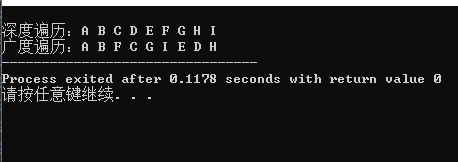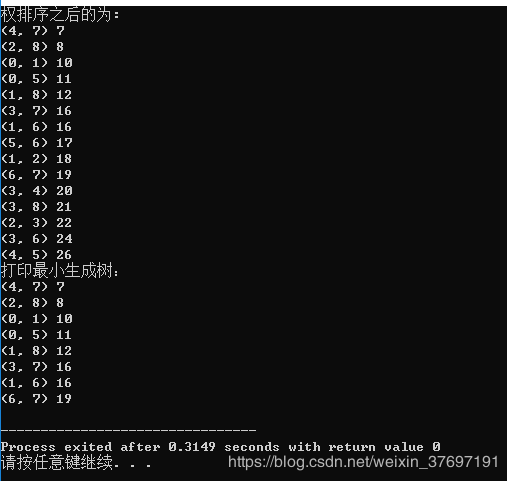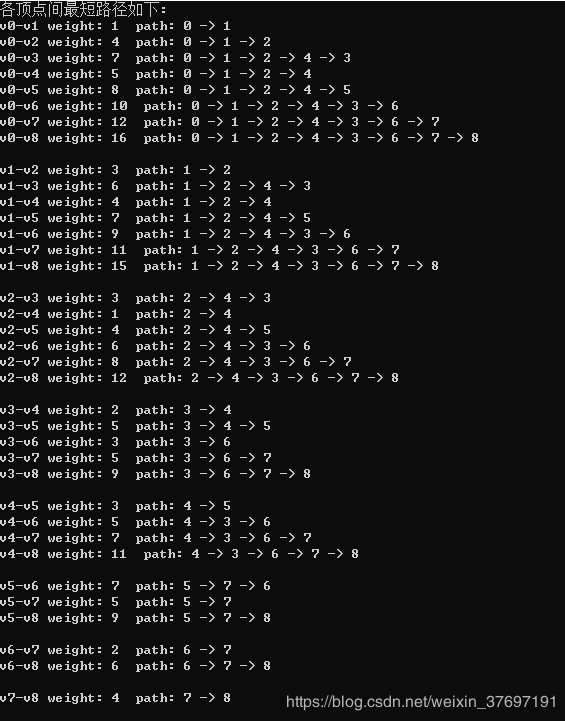数据结构C语言实现-6—图
Table of Contents
邻接矩阵创建
邻接表创建
邻接矩阵深度和广度遍历
邻接表深度和广度遍历
最小生成树—Prim
最小生成树—Kruskal
最短路径—Dijkstra
最短路径—Floyd
拓扑排序
理论部分见:数据结构理论基础-6—图
邻接矩阵创建
#include "stdio.h"
#include "stdlib.h"
#include "io.h"
#include "math.h"
#include "time.h"
#define OK 1
#define ERROR 0
#define TRUE 1
#define FALSE 0
#define MAXVEX 100 /* 最大顶点数,应由用户定义 */
#define INFINITY 65535 /* 无穷大 */
typedef int Status; /* Status是函数的类型,其值是函数结果状态代码,如OK等 */
typedef char VertexType; /* 顶点类型应由用户定义 */
typedef int EdgeType; /* 边上的权值类型应由用户定义 */
typedef struct
{
VertexType vexs[MAXVEX]; /* 顶点表 */
EdgeType arc[MAXVEX][MAXVEX];/* 邻接矩阵,可看作边表 */
int numNodes, numEdges; /* 图中当前的顶点数和边数 */
}MGraph;
/* 建立无向网图的邻接矩阵表示 */
void CreateMGraph(MGraph *G)
{
int i,j,k,w;
printf("输入顶点数和边数(英文输入):\n");
scanf("%d,%d",&G->numNodes,&G->numEdges); /* 输入顶点数和边数 */
for(i = 0;i numNodes;i++) /* 读入顶点信息,建立顶点表 */
scanf(&G->vexs[i]);
for(i = 0;i numNodes;i++)
for(j = 0;j numNodes;j++)
G->arc[i][j]=INFINITY; /* 邻接矩阵初始化 */
for(k = 0;k numEdges;k++) /* 读入numEdges条边,建立邻接矩阵 */
{
printf("输入边(vi,vj)上的下标i,下标j和权w:\n");
scanf("%d,%d,%d",&i,&j,&w); /* 输入边(vi,vj)上的权w */
G->arc[i][j]=w;
G->arc[j][i]= G->arc[i][j]; /* 因为是无向图,矩阵对称 */
}
}
int main(void)
{
MGraph G;
CreateMGraph(&G);
for(int i=0; i 邻接表创建
#include "stdio.h"
#include "stdlib.h"
#include "io.h"
#include "math.h"
#include "time.h"
#define OK 1
#define ERROR 0
#define TRUE 1
#define FALSE 0
#define MAXVEX 100 /* 最大顶点数,应由用户定义 */
typedef int Status; /* Status是函数的类型,其值是函数结果状态代码,如OK等 */
typedef char VertexType; /* 顶点类型应由用户定义 */
typedef int EdgeType; /* 边上的权值类型应由用户定义 */
typedef struct EdgeNode /* 边表结点 */
{
int adjvex; /* 邻接点域,存储该顶点对应的下标 */
EdgeType info; /* 用于存储权值,对于非网图可以不需要 */
struct EdgeNode *next; /* 链域,指向下一个邻接点 */
}EdgeNode;
typedef struct VertexNode /* 顶点表结点 */
{
VertexType data; /* 顶点域,存储顶点信息 */
EdgeNode *firstedge;/* 边表头指针 */
}VertexNode, AdjList[MAXVEX];
typedef struct
{
AdjList adjList;
int numNodes,numEdges; /* 图中当前顶点数和边数 */
}GraphAdjList;
/* 建立图的邻接表结构 */
void CreateALGraph(GraphAdjList *G)
{
int i,j,k;
EdgeNode *e;
printf("输入顶点数和边数:\n");
scanf("%d,%d",&G->numNodes,&G->numEdges); /* 输入顶点数和边数 */
for(i = 0;i < G->numNodes;i++) /* 读入顶点信息,建立顶点表 */
{
scanf(&G->adjList[i].data); /* 输入顶点信息 */
G->adjList[i].firstedge=NULL; /* 将边表置为空表 */
}
for(k = 0;k < G->numEdges;k++)/* 建立边表 */
{
printf("输入边(vi,vj)上的顶点序号:\n");
scanf("%d,%d",&i,&j); /* 输入边(vi,vj)上的顶点序号 */
e=(EdgeNode *)malloc(sizeof(EdgeNode)); /* 向内存申请空间,生成边表结点 */
e->adjvex=j; /* 邻接序号为j */
e->next=G->adjList[i].firstedge; /* 将e的指针指向当前顶点上指向的结点 */
G->adjList[i].firstedge=e; /* 将当前顶点的指针指向e */
e=(EdgeNode *)malloc(sizeof(EdgeNode)); /* 向内存申请空间,生成边表结点 */
e->adjvex=i; /* 邻接序号为i */
e->next=G->adjList[j].firstedge; /* 将e的指针指向当前顶点上指向的结点 */
G->adjList[j].firstedge=e; /* 将当前顶点的指针指向e */
}
}
int main(void)
{
GraphAdjList G;
CreateALGraph(&G);
return 0;
}
邻接矩阵深度和广度遍历
#include "stdio.h"
#include "stdlib.h"
#include "io.h"
#include "math.h"
#include "time.h"
#define OK 1
#define ERROR 0
#define TRUE 1
#define FALSE 0
typedef int Status; /* Status是函数的类型,其值是函数结果状态代码,如OK等 */
typedef int Boolean; /* Boolean是布尔类型,其值是TRUE或FALSE */
typedef char VertexType; /* 顶点类型应由用户定义 */
typedef int EdgeType; /* 边上的权值类型应由用户定义 */
#define MAXSIZE 9 /* 存储空间初始分配量 */
#define MAXEDGE 15
#define MAXVEX 9
#define INFINITY 65535
typedef struct
{
VertexType vexs[MAXVEX]; /* 顶点表 */
EdgeType arc[MAXVEX][MAXVEX];/* 邻接矩阵,可看作边表 */
int numVertexes, numEdges; /* 图中当前的顶点数和边数 */
}MGraph;
/* 用到的队列结构与函数********************************** */
/* 循环队列的顺序存储结构 */
typedef struct
{
int data[MAXSIZE];
int front; /* 头指针 */
int rear; /* 尾指针,若队列不空,指向队列尾元素的下一个位置 */
}Queue;
/* 初始化一个空队列Q */
Status InitQueue(Queue *Q)
{
Q->front=0;
Q->rear=0;
return OK;
}
/* 若队列Q为空队列,则返回TRUE,否则返回FALSE */
Status QueueEmpty(Queue Q)
{
if(Q.front==Q.rear) /* 队列空的标志 */
return TRUE;
else
return FALSE;
}
/* 若队列未满,则插入元素e为Q新的队尾元素 */
Status EnQueue(Queue *Q,int e)
{
if ((Q->rear+1)%MAXSIZE == Q->front) /* 队列满的判断 */
return ERROR;
Q->data[Q->rear]=e; /* 将元素e赋值给队尾 */
Q->rear=(Q->rear+1)%MAXSIZE;/* rear指针向后移一位置, */
/* 若到最后则转到数组头部 */
return OK;
}
/* 若队列不空,则删除Q中队头元素,用e返回其值 */
Status DeQueue(Queue *Q,int *e)
{
if (Q->front == Q->rear) /* 队列空的判断 */
return ERROR;
*e=Q->data[Q->front]; /* 将队头元素赋值给e */
Q->front=(Q->front+1)%MAXSIZE; /* front指针向后移一位置, */
/* 若到最后则转到数组头部 */
return OK;
}
/* ****************************************************** */
void CreateMGraph(MGraph *G)
{
int i, j;
G->numEdges=15;
G->numVertexes=9;
/* 读入顶点信息,建立顶点表 */
G->vexs[0]='A';
G->vexs[1]='B';
G->vexs[2]='C';
G->vexs[3]='D';
G->vexs[4]='E';
G->vexs[5]='F';
G->vexs[6]='G';
G->vexs[7]='H';
G->vexs[8]='I';
for (i = 0; i < G->numVertexes; i++)/* 初始化图 */
{
for ( j = 0; j < G->numVertexes; j++)
{
G->arc[i][j]=0;
}
}
G->arc[0][1]=1;
G->arc[0][5]=1;
G->arc[1][2]=1;
G->arc[1][8]=1;
G->arc[1][6]=1;
G->arc[2][3]=1;
G->arc[2][8]=1;
G->arc[3][4]=1;
G->arc[3][7]=1;
G->arc[3][6]=1;
G->arc[3][8]=1;
G->arc[4][5]=1;
G->arc[4][7]=1;
G->arc[5][6]=1;
G->arc[6][7]=1;
for(i = 0; i < G->numVertexes; i++)
{
for(j = i; j < G->numVertexes; j++)
{
G->arc[j][i] =G->arc[i][j];
}
}
}
Boolean visited[MAXVEX]; /* 访问标志的数组 */
/* 邻接矩阵的深度优先递归算法 */
void DFS(MGraph G, int i)
{
int j;
visited[i] = TRUE;
printf("%c ", G.vexs[i]);/* 打印顶点,也可以其它操作 */
for(j = 0; j < G.numVertexes; j++)
if(G.arc[i][j] == 1 && !visited[j])
DFS(G, j);/* 对为访问的邻接顶点递归调用 */
}
/* 邻接矩阵的深度遍历操作 */
void DFSTraverse(MGraph G)
{
int i;
for(i = 0; i < G.numVertexes; i++)
visited[i] = FALSE; /* 初始所有顶点状态都是未访问过状态 */
for(i = 0; i < G.numVertexes; i++)
if(!visited[i]) /* 对未访问过的顶点调用DFS,若是连通图,只会执行一次 */
DFS(G, i);
}
/* 邻接矩阵的广度遍历算法 */
void BFSTraverse(MGraph G)
{
int i, j;
Queue Q;
for(i = 0; i < G.numVertexes; i++)
visited[i] = FALSE;
InitQueue(&Q); /* 初始化一辅助用的队列 */
for(i = 0; i < G.numVertexes; i++) /* 对每一个顶点做循环 */
{
if (!visited[i]) /* 若是未访问过就处理 */
{
visited[i]=TRUE; /* 设置当前顶点访问过 */
printf("%c ", G.vexs[i]);/* 打印顶点,也可以其它操作 */
EnQueue(&Q,i); /* 将此顶点入队列 */
while(!QueueEmpty(Q)) /* 若当前队列不为空 */
{
DeQueue(&Q,&i); /* 将队对元素出队列,赋值给i */
for(j=0;j邻接表深度和广度遍历
#include "stdio.h"
#include "stdlib.h"
#include "io.h"
#include "math.h"
#include "time.h"
#define OK 1
#define ERROR 0
#define TRUE 1
#define FALSE 0
#define MAXSIZE 9 /* 存储空间初始分配量 */
#define MAXEDGE 15
#define MAXVEX 9
#define INFINITY 65535
typedef int Status; /* Status是函数的类型,其值是函数结果状态代码,如OK等 */
typedef int Boolean; /* Boolean是布尔类型,其值是TRUE或FALSE */
typedef char VertexType; /* 顶点类型应由用户定义 */
typedef int EdgeType; /* 边上的权值类型应由用户定义 */
/* 邻接矩阵结构 */
typedef struct
{
VertexType vexs[MAXVEX]; /* 顶点表 */
EdgeType arc[MAXVEX][MAXVEX];/* 邻接矩阵,可看作边表 */
int numVertexes, numEdges; /* 图中当前的顶点数和边数 */
}MGraph;
/* 邻接表结构****************** */
typedef struct EdgeNode /* 边表结点 */
{
int adjvex; /* 邻接点域,存储该顶点对应的下标 */
int weight; /* 用于存储权值,对于非网图可以不需要 */
struct EdgeNode *next; /* 链域,指向下一个邻接点 */
}EdgeNode;
typedef struct VertexNode /* 顶点表结点 */
{
int in; /* 顶点入度 */
char data; /* 顶点域,存储顶点信息 */
EdgeNode *firstedge;/* 边表头指针 */
}VertexNode, AdjList[MAXVEX];
typedef struct
{
AdjList adjList;
int numVertexes,numEdges; /* 图中当前顶点数和边数 */
}graphAdjList,*GraphAdjList;
/* **************************** */
/* 用到的队列结构与函数********************************** */
/* 循环队列的顺序存储结构 */
typedef struct
{
int data[MAXSIZE];
int front; /* 头指针 */
int rear; /* 尾指针,若队列不空,指向队列尾元素的下一个位置 */
}Queue;
/* 初始化一个空队列Q */
Status InitQueue(Queue *Q)
{
Q->front=0;
Q->rear=0;
return OK;
}
/* 若队列Q为空队列,则返回TRUE,否则返回FALSE */
Status QueueEmpty(Queue Q)
{
if(Q.front==Q.rear) /* 队列空的标志 */
return TRUE;
else
return FALSE;
}
/* 若队列未满,则插入元素e为Q新的队尾元素 */
Status EnQueue(Queue *Q,int e)
{
if ((Q->rear+1)%MAXSIZE == Q->front) /* 队列满的判断 */
return ERROR;
Q->data[Q->rear]=e; /* 将元素e赋值给队尾 */
Q->rear=(Q->rear+1)%MAXSIZE;/* rear指针向后移一位置, */
/* 若到最后则转到数组头部 */
return OK;
}
/* 若队列不空,则删除Q中队头元素,用e返回其值 */
Status DeQueue(Queue *Q,int *e)
{
if (Q->front == Q->rear) /* 队列空的判断 */
return ERROR;
*e=Q->data[Q->front]; /* 将队头元素赋值给e */
Q->front=(Q->front+1)%MAXSIZE; /* front指针向后移一位置, */
/* 若到最后则转到数组头部 */
return OK;
}
/* ****************************************************** */
void CreateMGraph(MGraph *G)
{
int i, j;
G->numEdges=15;
G->numVertexes=9;
/* 读入顶点信息,建立顶点表 */
G->vexs[0]='A';
G->vexs[1]='B';
G->vexs[2]='C';
G->vexs[3]='D';
G->vexs[4]='E';
G->vexs[5]='F';
G->vexs[6]='G';
G->vexs[7]='H';
G->vexs[8]='I';
for (i = 0; i < G->numVertexes; i++)/* 初始化图 */
{
for ( j = 0; j < G->numVertexes; j++)
{
G->arc[i][j]=0;
}
}
G->arc[0][1]=1;
G->arc[0][5]=1;
G->arc[1][2]=1;
G->arc[1][8]=1;
G->arc[1][6]=1;
G->arc[2][3]=1;
G->arc[2][8]=1;
G->arc[3][4]=1;
G->arc[3][7]=1;
G->arc[3][6]=1;
G->arc[3][8]=1;
G->arc[4][5]=1;
G->arc[4][7]=1;
G->arc[5][6]=1;
G->arc[6][7]=1;
for(i = 0; i < G->numVertexes; i++)
{
for(j = i; j < G->numVertexes; j++)
{
G->arc[j][i] =G->arc[i][j];
}
}
}
/* 利用邻接矩阵构建邻接表 */
void CreateALGraph(MGraph G,GraphAdjList *GL)
{
int i,j;
EdgeNode *e;
*GL = (GraphAdjList)malloc(sizeof(graphAdjList));
(*GL)->numVertexes=G.numVertexes;
(*GL)->numEdges=G.numEdges;
for(i= 0;i adjList[i].in=0;
(*GL)->adjList[i].data=G.vexs[i];
(*GL)->adjList[i].firstedge=NULL; /* 将边表置为空表 */
}
for(i=0;iadjvex=j; /* 邻接序号为j */
e->next=(*GL)->adjList[i].firstedge; /* 将当前顶点上的指向的结点指针赋值给e */
(*GL)->adjList[i].firstedge=e; /* 将当前顶点的指针指向e */
(*GL)->adjList[j].in++;
}
}
}
}
Boolean visited[MAXSIZE]; /* 访问标志的数组 */
/* 邻接表的深度优先递归算法 */
void DFS(GraphAdjList GL, int i)
{
EdgeNode *p;
visited[i] = TRUE;
printf("%c ",GL->adjList[i].data);/* 打印顶点,也可以其它操作 */
p = GL->adjList[i].firstedge;
while(p)
{
if(!visited[p->adjvex])
DFS(GL, p->adjvex);/* 对为访问的邻接顶点递归调用 */
p = p->next;
}
}
/* 邻接表的深度遍历操作 */
void DFSTraverse(GraphAdjList GL)
{
int i;
for(i = 0; i < GL->numVertexes; i++)
visited[i] = FALSE; /* 初始所有顶点状态都是未访问过状态 */
for(i = 0; i < GL->numVertexes; i++)
if(!visited[i]) /* 对未访问过的顶点调用DFS,若是连通图,只会执行一次 */
DFS(GL, i);
}
/* 邻接表的广度遍历算法 */
void BFSTraverse(GraphAdjList GL)
{
int i;
EdgeNode *p;
Queue Q;
for(i = 0; i < GL->numVertexes; i++)
visited[i] = FALSE;
InitQueue(&Q);
for(i = 0; i < GL->numVertexes; i++)
{
if (!visited[i])
{
visited[i]=TRUE;
printf("%c ",GL->adjList[i].data);/* 打印顶点,也可以其它操作 */
EnQueue(&Q,i);
while(!QueueEmpty(Q))
{
DeQueue(&Q,&i);
p = GL->adjList[i].firstedge; /* 找到当前顶点的边表链表头指针 */
while(p)
{
if(!visited[p->adjvex]) /* 若此顶点未被访问 */
{
visited[p->adjvex]=TRUE;
printf("%c ",GL->adjList[p->adjvex].data);
EnQueue(&Q,p->adjvex); /* 将此顶点入队列 */
}
p = p->next; /* 指针指向下一个邻接点 */
}
}
}
}
}
int main(void)
{
MGraph G;
GraphAdjList GL;
CreateMGraph(&G);
CreateALGraph(G,&GL);
printf("\n深度遍历:");
DFSTraverse(GL);
printf("\n广度遍历:");
BFSTraverse(GL);
return 0;
}
最小生成树—Prim
#include "stdio.h"
#include "stdlib.h"
#include "io.h"
#include "math.h"
#include "time.h"
#define OK 1
#define ERROR 0
#define TRUE 1
#define FALSE 0
#define MAXEDGE 20
#define MAXVEX 20
#define INFINITY 65535
typedef int Status; /* Status是函数的类型,其值是函数结果状态代码,如OK等 */
typedef struct
{
int arc[MAXVEX][MAXVEX];
int numVertexes, numEdges;
}MGraph;
void CreateMGraph(MGraph *G)/* 构件图 */
{
int i, j;
/* printf("请输入边数和顶点数:"); */
G->numEdges=15;
G->numVertexes=9;
for (i = 0; i < G->numVertexes; i++)/* 初始化图 */
{
for ( j = 0; j < G->numVertexes; j++)
{
if (i==j)
G->arc[i][j]=0;
else
G->arc[i][j] = G->arc[j][i] = INFINITY;
}
}
G->arc[0][1]=10;
G->arc[0][5]=11;
G->arc[1][2]=18;
G->arc[1][8]=12;
G->arc[1][6]=16;
G->arc[2][8]=8;
G->arc[2][3]=22;
G->arc[3][8]=21;
G->arc[3][6]=24;
G->arc[3][7]=16;
G->arc[3][4]=20;
G->arc[4][7]=7;
G->arc[4][5]=26;
G->arc[5][6]=17;
G->arc[6][7]=19;
for(i = 0; i < G->numVertexes; i++)
{
for(j = i; j < G->numVertexes; j++)
{
G->arc[j][i] =G->arc[i][j];
}
}
}
/* Prim算法生成最小生成树 */
void MiniSpanTree_Prim(MGraph G)
{
int min, i, j, k;
int adjvex[MAXVEX]; /* 保存相关顶点下标 */
int lowcost[MAXVEX]; /* 保存相关顶点间边的权值 */
lowcost[0] = 0;/* 初始化第一个权值为0,即v0加入生成树 */
/* lowcost的值为0,在这里就是此下标的顶点已经加入生成树 */
adjvex[0] = 0; /* 初始化第一个顶点下标为0 */
for(i = 1; i < G.numVertexes; i++) /* 循环除下标为0外的全部顶点 */
{
lowcost[i] = G.arc[0][i]; /* 将v0顶点与之有边的权值存入数组 */
adjvex[i] = 0; /* 初始化都为v0的下标 */
}
for(i = 1; i < G.numVertexes; i++)
{
min = INFINITY; /* 初始化最小权值为∞, */
/* 通常设置为不可能的大数字如32767、65535等 */
j = 1;k = 0;
while(j < G.numVertexes) /* 循环全部顶点 */
{
if(lowcost[j]!=0 && lowcost[j] < min)/* 如果权值不为0且权值小于min */
{
min = lowcost[j]; /* 则让当前权值成为最小值 */
k = j; /* 将当前最小值的下标存入k */
}
j++;
}
printf("(%d, %d)\n", adjvex[k], k);/* 打印当前顶点边中权值最小的边 */
lowcost[k] = 0;/* 将当前顶点的权值设置为0,表示此顶点已经完成任务 */
for(j = 1; j < G.numVertexes; j++) /* 循环所有顶点 */
{
if(lowcost[j]!=0 && G.arc[k][j] < lowcost[j])
{/* 如果下标为k顶点各边权值小于此前这些顶点未被加入生成树权值 */
lowcost[j] = G.arc[k][j];/* 将较小的权值存入lowcost相应位置 */
adjvex[j] = k; /* 将下标为k的顶点存入adjvex */
}
}
}
}
int main(void)
{
MGraph G;
CreateMGraph(&G);
MiniSpanTree_Prim(G);
return 0;
}最小生成树—Kruskal
#include "stdio.h"
#include "stdlib.h"
#include "io.h"
#include "math.h"
#include "time.h"
#define OK 1
#define ERROR 0
#define TRUE 1
#define FALSE 0
typedef int Status; /* Status是函数的类型,其值是函数结果状态代码,如OK等 */
#define MAXEDGE 20
#define MAXVEX 20
#define INFINITY 65535
typedef struct
{
int arc[MAXVEX][MAXVEX];
int numVertexes, numEdges;
}MGraph;
typedef struct
{
int begin;
int end;
int weight;
}Edge; /* 对边集数组Edge结构的定义 */
/* 构件图 */
void CreateMGraph(MGraph *G)
{
int i, j;
/* printf("请输入边数和顶点数:"); */
G->numEdges=15;
G->numVertexes=9;
for (i = 0; i < G->numVertexes; i++)/* 初始化图 */
{
for ( j = 0; j < G->numVertexes; j++)
{
if (i==j)
G->arc[i][j]=0;
else
G->arc[i][j] = G->arc[j][i] = INFINITY;
}
}
G->arc[0][1]=10;
G->arc[0][5]=11;
G->arc[1][2]=18;
G->arc[1][8]=12;
G->arc[1][6]=16;
G->arc[2][8]=8;
G->arc[2][3]=22;
G->arc[3][8]=21;
G->arc[3][6]=24;
G->arc[3][7]=16;
G->arc[3][4]=20;
G->arc[4][7]=7;
G->arc[4][5]=26;
G->arc[5][6]=17;
G->arc[6][7]=19;
for(i = 0; i < G->numVertexes; i++)
{
for(j = i; j < G->numVertexes; j++)
{
G->arc[j][i] =G->arc[i][j];
}
}
}
/* 交换权值 以及头和尾 */
void Swapn(Edge *edges,int i, int j)
{
int temp;
temp = edges[i].begin;
edges[i].begin = edges[j].begin;
edges[j].begin = temp;
temp = edges[i].end;
edges[i].end = edges[j].end;
edges[j].end = temp;
temp = edges[i].weight;
edges[i].weight = edges[j].weight;
edges[j].weight = temp;
}
/* 对权值进行排序 */
void sort(Edge edges[],MGraph *G)
{
int i, j;
for ( i = 0; i < G->numEdges; i++)
{
for ( j = i + 1; j < G->numEdges; j++)
{
if (edges[i].weight > edges[j].weight)
{
Swapn(edges, i, j);
}
}
}
printf("权排序之后的为:\n");
for (i = 0; i < G->numEdges; i++)
{
printf("(%d, %d) %d\n", edges[i].begin, edges[i].end, edges[i].weight);
}
}
/* 查找连线顶点的尾部下标 */
int Find(int *parent, int f)
{
while ( parent[f] > 0)
{
f = parent[f];
}
return f;
}
/* 生成最小生成树 */
void MiniSpanTree_Kruskal(MGraph G)
{
int i, j, n, m;
int k = 0;
int parent[MAXVEX];/* 定义一数组用来判断边与边是否形成环路 */
Edge edges[MAXEDGE];/* 定义边集数组,edge的结构为begin,end,weight,均为整型 */
/* 用来构建边集数组并排序********************* */
for ( i = 0; i < G.numVertexes-1; i++)
{
for (j = i + 1; j < G.numVertexes; j++)
{
if (G.arc[i][j]最短路径—Dijkstra
#include "stdio.h"
#include "stdlib.h"
#include "io.h"
#include "math.h"
#include "time.h"
#define OK 1
#define ERROR 0
#define TRUE 1
#define FALSE 0
#define MAXEDGE 20
#define MAXVEX 20
#define INFINITY 65535
typedef int Status; /* Status是函数的类型,其值是函数结果状态代码,如OK等 */
typedef struct
{
int vexs[MAXVEX];
int arc[MAXVEX][MAXVEX];
int numVertexes, numEdges;
}MGraph;
typedef int Patharc[MAXVEX]; /* 用于存储最短路径下标的数组 */
typedef int ShortPathTable[MAXVEX];/* 用于存储到各点最短路径的权值和 */
/* 构件图 */
void CreateMGraph(MGraph *G)
{
int i, j;
/* printf("请输入边数和顶点数:"); */
G->numEdges=16;
G->numVertexes=9;
for (i = 0; i < G->numVertexes; i++)/* 初始化图 */
{
G->vexs[i]=i;
}
for (i = 0; i < G->numVertexes; i++)/* 初始化图 */
{
for ( j = 0; j < G->numVertexes; j++)
{
if (i==j)
G->arc[i][j]=0;
else
G->arc[i][j] = G->arc[j][i] = INFINITY;
}
}
G->arc[0][1]=1;
G->arc[0][2]=5;
G->arc[1][2]=3;
G->arc[1][3]=7;
G->arc[1][4]=5;
G->arc[2][4]=1;
G->arc[2][5]=7;
G->arc[3][4]=2;
G->arc[3][6]=3;
G->arc[4][5]=3;
G->arc[4][6]=6;
G->arc[4][7]=9;
G->arc[5][7]=5;
G->arc[6][7]=2;
G->arc[6][8]=7;
G->arc[7][8]=4;
for(i = 0; i < G->numVertexes; i++)
{
for(j = i; j < G->numVertexes; j++)
{
G->arc[j][i] =G->arc[i][j];
}
}
}
/* Dijkstra算法,求有向网G的v0顶点到其余顶点v的最短路径P[v]及带权长度D[v] */
/* P[v]的值为前驱顶点下标,D[v]表示v0到v的最短路径长度和 */
void ShortestPath_Dijkstra(MGraph G, int v0, Patharc *P, ShortPathTable *D)
{
int v,w,k,min;
int final[MAXVEX];/* final[w]=1表示求得顶点v0至vw的最短路径 */
for(v=0; v最短路径—Floyd
#include "stdio.h"
#include "stdlib.h"
#include "io.h"
#include "math.h"
#include "time.h"
#define OK 1
#define ERROR 0
#define TRUE 1
#define FALSE 0
#define MAXEDGE 20
#define MAXVEX 20
#define INFINITY 65535
typedef int Status; /* Status是函数的类型,其值是函数结果状态代码,如OK等 */
typedef struct
{
int vexs[MAXVEX];
int arc[MAXVEX][MAXVEX];
int numVertexes, numEdges;
}MGraph;
typedef int Patharc[MAXVEX][MAXVEX];
typedef int ShortPathTable[MAXVEX][MAXVEX];
/* 构件图 */
void CreateMGraph(MGraph *G)
{
int i, j;
/* printf("请输入边数和顶点数:"); */
G->numEdges=16;
G->numVertexes=9;
for (i = 0; i < G->numVertexes; i++)/* 初始化图 */
{
G->vexs[i]=i;
}
for (i = 0; i < G->numVertexes; i++)/* 初始化图 */
{
for ( j = 0; j < G->numVertexes; j++)
{
if (i==j)
G->arc[i][j]=0;
else
G->arc[i][j] = G->arc[j][i] = INFINITY;
}
}
G->arc[0][1]=1;
G->arc[0][2]=5;
G->arc[1][2]=3;
G->arc[1][3]=7;
G->arc[1][4]=5;
G->arc[2][4]=1;
G->arc[2][5]=7;
G->arc[3][4]=2;
G->arc[3][6]=3;
G->arc[4][5]=3;
G->arc[4][6]=6;
G->arc[4][7]=9;
G->arc[5][7]=5;
G->arc[6][7]=2;
G->arc[6][8]=7;
G->arc[7][8]=4;
for(i = 0; i < G->numVertexes; i++)
{
for(j = i; j < G->numVertexes; j++)
{
G->arc[j][i] =G->arc[i][j];
}
}
}
/* Floyd算法,求网图G中各顶点v到其余顶点w的最短路径P[v][w]及带权长度D[v][w]。 */
void ShortestPath_Floyd(MGraph G, Patharc *P, ShortPathTable *D)
{
int v,w,k;
for(v=0; v(*D)[v][k]+(*D)[k][w])
{/* 如果经过下标为k顶点路径比原两点间路径更短 */
(*D)[v][w]=(*D)[v][k]+(*D)[k][w];/* 将当前两点间权值设为更小的一个 */
(*P)[v][w]=(*P)[v][k];/* 路径设置为经过下标为k的顶点 */
}
}
}
}
}
int main(void)
{
int v,w,k;
MGraph G;
Patharc P;
ShortPathTable D; /* 求某点到其余各点的最短路径 */
CreateMGraph(&G);
ShortestPath_Floyd(G,&P,&D);
printf("各顶点间最短路径如下:\n");
for(v=0; v %d",k); /* 打印路径顶点 */
k=P[k][w]; /* 获得下一个路径顶点下标 */
}
printf(" -> %d\n",w); /* 打印终点 */
}
printf("\n");
}
printf("最短路径D\n");
for(v=0; v 拓扑排序
#include "stdio.h"
#include "stdlib.h"
#include "io.h"
#include "math.h"
#include "time.h"
#define OK 1
#define ERROR 0
#define TRUE 1
#define FALSE 0
#define MAXEDGE 20
#define MAXVEX 14
#define INFINITY 65535
typedef int Status; /* Status是函数的类型,其值是函数结果状态代码,如OK等 */
/* 邻接矩阵结构 */
typedef struct
{
int vexs[MAXVEX];
int arc[MAXVEX][MAXVEX];
int numVertexes, numEdges;
}MGraph;
/* 邻接表结构****************** */
typedef struct EdgeNode /* 边表结点 */
{
int adjvex; /* 邻接点域,存储该顶点对应的下标 */
int weight; /* 用于存储权值,对于非网图可以不需要 */
struct EdgeNode *next; /* 链域,指向下一个邻接点 */
}EdgeNode;
typedef struct VertexNode /* 顶点表结点 */
{
int in; /* 顶点入度 */
int data; /* 顶点域,存储顶点信息 */
EdgeNode *firstedge;/* 边表头指针 */
}VertexNode, AdjList[MAXVEX];
typedef struct
{
AdjList adjList;
int numVertexes,numEdges; /* 图中当前顶点数和边数 */
}graphAdjList,*GraphAdjList;
/* **************************** */
void CreateMGraph(MGraph *G)/* 构件图 */
{
int i, j;
/* printf("请输入边数和顶点数:"); */
G->numEdges=MAXEDGE;
G->numVertexes=MAXVEX;
for (i = 0; i < G->numVertexes; i++)/* 初始化图 */
{
G->vexs[i]=i;
}
for (i = 0; i < G->numVertexes; i++)/* 初始化图 */
{
for ( j = 0; j < G->numVertexes; j++)
{
G->arc[i][j]=0;
}
}
G->arc[0][4]=1;
G->arc[0][5]=1;
G->arc[0][11]=1;
G->arc[1][2]=1;
G->arc[1][4]=1;
G->arc[1][8]=1;
G->arc[2][5]=1;
G->arc[2][6]=1;
G->arc[2][9]=1;
G->arc[3][2]=1;
G->arc[3][13]=1;
G->arc[4][7]=1;
G->arc[5][8]=1;
G->arc[5][12]=1;
G->arc[6][5]=1;
G->arc[8][7]=1;
G->arc[9][10]=1;
G->arc[9][11]=1;
G->arc[10][13]=1;
G->arc[12][9]=1;
}
/* 利用邻接矩阵构建邻接表 */
void CreateALGraph(MGraph G,GraphAdjList *GL)
{
int i,j;
EdgeNode *e;
*GL = (GraphAdjList)malloc(sizeof(graphAdjList));
(*GL)->numVertexes=G.numVertexes;
(*GL)->numEdges=G.numEdges;
for(i= 0;i adjList[i].in=0;
(*GL)->adjList[i].data=G.vexs[i];
(*GL)->adjList[i].firstedge=NULL; /* 将边表置为空表 */
}
for(i=0;iadjvex=j; /* 邻接序号为j */
e->next=(*GL)->adjList[i].firstedge; /* 将当前顶点上的指向的结点指针赋值给e */
(*GL)->adjList[i].firstedge=e; /* 将当前顶点的指针指向e */
(*GL)->adjList[j].in++;
}
}
}
}
/* 拓扑排序,若GL无回路,则输出拓扑排序序列并返回1,若有回路返回0。 */
Status TopologicalSort(GraphAdjList GL)
{
EdgeNode *e;
int i,k,gettop;
int top=0; /* 用于栈指针下标 */
int count=0;/* 用于统计输出顶点的个数 */
int *stack; /* 建栈将入度为0的顶点入栈 */
stack=(int *)malloc(GL->numVertexes * sizeof(int) );
for(i = 0; inumVertexes; i++)
if(0 == GL->adjList[i].in) /* 将入度为0的顶点入栈 */
stack[++top]=i;
while(top!=0)
{
gettop=stack[top--];
printf("%d -> ",GL->adjList[gettop].data);
count++; /* 输出i号顶点,并计数 */
for(e = GL->adjList[gettop].firstedge; e; e = e->next)
{
k=e->adjvex;
if( !(--GL->adjList[k].in) ) /* 将i号顶点的邻接点的入度减1,如果减1后为0,则入栈 */
stack[++top]=k;
}
}
printf("\n");
if(count < GL->numVertexes)
return ERROR;
else
return OK;
}
int main(void)
{
MGraph G;
GraphAdjList GL;
int result;
CreateMGraph(&G);
CreateALGraph(G,&GL);
result=TopologicalSort(GL);
printf("result:%d",result);
return 0;
}








